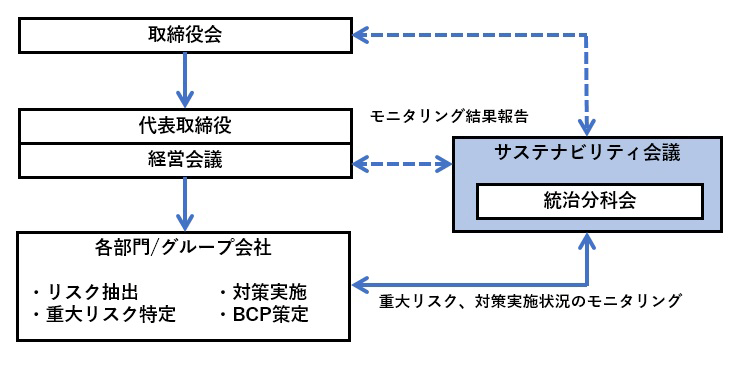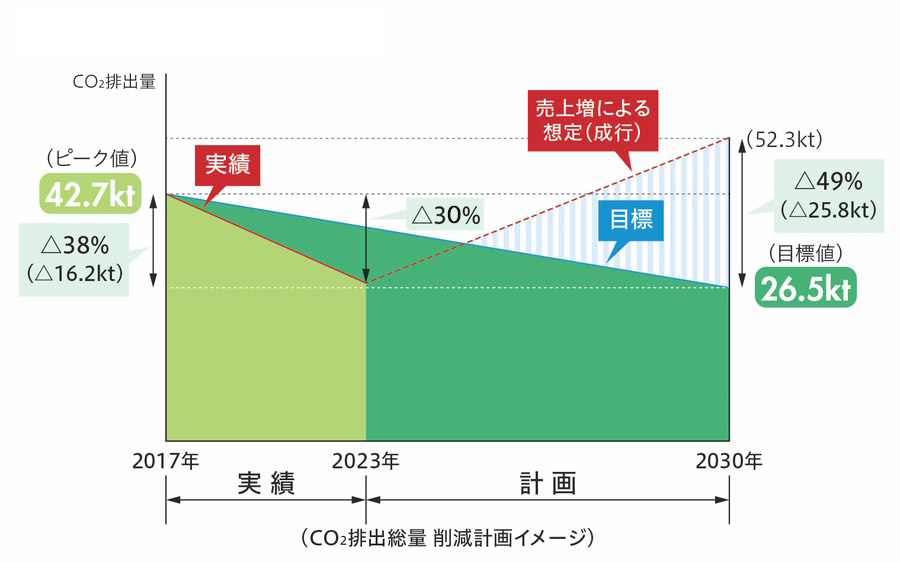TCFD提言への賛同と情報開示
新明和工業は、気候変動に関する財務情報開示を積極的に進めていくというTCFD提言の趣旨に2023年1月に賛同し、TCFD提言に基づく情報を開示いたしました。
今後もTCFD提言のフレームワークを活用して、継続的に情報開示の質と量を充実させるとともに、気候変動への取り組みを一層推進し、持続可能な社会の実現に貢献してまいります。
1. ガバナンス
代表取締役取締役社長を議長とする取締役会は、気候関連リスク・機会を企業経営に関する重要な課題・テーマとして捉え、監督・審議する責務を担っています。当社の取締役会は原則として毎月1回開催され、中期経営計画に基づき気候変動を含む重要な経営課題について議論、検討するなど、取締役および執行役員の業務執行について監督を行っています。
当社は、持続的な企業価値の向上と社会的価値を創造するため、年2回、サステナビリティ会議を開催しています。本会議は社長を議長とし、社内取締役、本社執行役員、事業部長などで構成され、サステナビリティに関する重要情報の適切な把握・評価および改善措置の提言を行っています。
気候関連リスク・機会も重要課題のひとつとしてこの枠組みの中で取り扱われ、同会議で、これらの動向のモニタリングも行っています。

2. 戦略
気候変動が当社事業にもたらす潜在的な影響の大きさと長期的な不確実性に鑑み、当社事業に関わる気候関連リスク・機会を特定・評価するプロセスとして、シナリオ分析を行っています。
5つある事業部のうち、特装車事業および流体事業の2事業については2022年度にシナリオ分析を実施、残りの3事業であるパーキングシステム事業、産機・環境システム事業、航空機事業については2023年度にシナリオ分析を実施しました。
1.5℃/2.0℃シナリオ(世界全体で2050年のネットゼロが実現するシナリオ)と、4.0℃シナリオ(経済活動を優先した結果、気候変動が進行し、異常気象や災害の激甚化などが起こるシナリオ)の2つのシナリオによる世界観を想定し、気候関連リスク・機会を特定しました。
具体的なシナリオ分析のプロセスとシナリオ分析結果は以下の通りです。
また、これらの気候関連のシナリオ分析結果は、2024年度からスタートした中期経営計画[SG-2026]に反映され、各事業部門における事業戦略に展開されています。
- <シナリオ分析のプロセス>
-

- <シナリオ分析結果>
| シナリオ | 外部環境の変化 | シナリオ分析結果 | 顕在化時期 | |||
|---|---|---|---|---|---|---|
| 1.5℃/2.0℃ シナリオ |
・GHG排出に対する規制強化 ・低炭素化技術への移行 ・市場構造の変化 |
リスク |
共通 |
|
中〜長期 |
|
|
特装車 |
|
中〜長期 |
||||
|
パーキング |
|
中〜長期 |
||||
|
中期 |
|||||
|
産機・環境 |
メカトロ |
|
中期 |
|||
|
中〜長期 |
|||||
|
環境 |
|
中〜長期 |
||||
|
長期 |
|||||
|
流体 |
|
中〜長期 |
||||
|
航空機 |
|
中〜長期 |
||||
|
機会 |
特装車 |
|
中〜長期 |
|||
|
パーキング |
|
中期 |
||||
|
中〜長期 |
|||||
|
産機・環境 |
メカトロ |
|
中〜長期 |
|||
|
環境 |
|
中〜長期 |
||||
|
流体 |
|
中〜長期 |
||||
|
航空機 |
|
中〜長期 |
||||
|
短〜長期 |
|||||
| 4.0℃ シナリオ |
・豪雨、洪水、台風等の気象災害の激甚化 |
リスク |
共通 (※) |
|
長期 |
|
|
機会 |
特装車 |
|
短〜長期 |
|||
|
パーキング |
|
中〜長期 |
||||
|
産機・環境 |
メカトロ |
|
中〜長期 |
|||
|
環境 |
|
中〜長期 |
||||
|
流体 |
|
中〜長期 |
||||
|
航空機 |
|
中〜長期 |
||||
- 時間軸の定義
短期:~2023年 中期:~2030年 長期:~2050年 - 使用シナリオ
1.5℃/2.0℃シナリオ:IEA Energy Outlook、IPCC第5次評価報告書2.0℃シナリオ(RCP2.6)
4.0℃シナリオ:IPCC第6次評価報告書、IPCC第5次評価報告書4.0℃シナリオ(RCP8.5)
3. リスク管理
事業遂行にかかるリスクについては、「新明和グループリスクマネジメント規程」を定め、各事業部およびグループ会社において事業特性に適合したリスクマネジメント体制を主体的に構築しています。一方で、本社においては各事業部およびグループ会社のリスクマネジメントの状況をモニタリングするとともに、災害リスクや財務リスク等、全社横断的なリスク対策を実施することにより、リスクマネジメント体制を確立しています。
また、サステナビリティ会議は、本社および事業部門から報告を受けた情報に基づき、当社グループにおけるリスクマネジメント体制の整備状況および活動状況を確認するとともに、事業運営に及ぼす影響等に照らして全社の重大リスクを特定し、これらの情報を経営会議および取締役会に対し定期的に報告することにより、当社グループにおけるリスクマネジメントの有効性の確保に努めています。
気候変動については、気候変動が当社事業にもたらす潜在的な影響の大きさと長期的な不確実性に鑑み、当社事業に関わる気候関連リスク・機会を特定・評価するプロセスとして、2022年度に初めて2つの事業を対象にシナリオ分析を行いました。このシナリオ分析で明らかになった気候関連リスク・機会のうち、特に重大なものは、重大リスクとして上記の全社的なリスクマネジメントの枠組みの中で管理していきます。

4. 指標と目標
当社は現在、2030年までの中期的な温室効果ガス削減目標として「エネルギー使用に伴うCO2排出総量を2030年度までに38%削減(2017年度比)」という目標を掲げています。これは、2017年度の当社のエネルギー使用に伴うCO2排出量42,720t-CO2eを2030年度の実績で26,486t-CO2eにまで減少させるものです。
また、過去のScope1、2の排出量実績(単体)は下表のとおりで、2024年度からは海外を含めた主要な連結子会社からの排出量も算定・加算しました。
Scope3については単体での排出量算定に留まっていますが、今後は連結子会社を含めた算定についても取り組みを進めていく計画です。
CO2排出総量 削減計画(単体)

Scope1、Scope2 排出量(単体)
| 基準年 | 過去5年間実績 | 目標値 | |||||
|---|---|---|---|---|---|---|---|
| 管理指標 | 2017年度 | 2020年度 | 2021年度 | 2022年度 | 2023年度 | 2024年度 | 2030年度 |
| Scope1 | 11,754 | 10,528 | 9,796 | 9,494 | 9,474 | 8,839 | ― |
| Scope2 | 30,966 | 20,321 | 20,682 | 17,918 | 19,918 | 18,007 | ― |
| Scope1+2 | 42,720 | 30,849 | 30,478 | 27,412 | 29,392 | 26,846 | 26,486 |
- ※1新明和工業単独の数値
Scope1、Scope2 排出量(国内連結)
| 管理指標 | 2023年度 | 2024年度 |
|---|---|---|
| Scope1 | 12,442 | 12,236 |
| Scope2 | 28,686 | 31,172 |
| Scope1+Scope2合計 | 41,128 | 43,408 |
対象とした主な連結子会社

Scope3 排出量(単体)
| カテゴリー | 2023年度 | 2024年度 | |
|---|---|---|---|
| 1 | 購入した製品・サービス | 605,545 | 602,090 |
| 2 | 資本財 | 10,794 | 12,419 |
| 3 | Scope1、2に含まれない燃料およびエネルギー関連活動 | 4,520 | 4,118 |
| 4 | 輸送、配送(上流) | 3,158 | 3,279 |
| 5 | 事業活動から出る廃棄物 | 825 | 1,099 |
| 6 | 出張 | 423 | 450 |
| 7 | 雇用者の通勤 | 1,153 | 1,220 |
| 8 | リース資産(上流) | 非該当 | 非該当 |
| 9 | 輸送、配送(下流) | 非該当 | 非該当 |
| 10 | 販売した製品の加工 | 非該当 | 非該当 |
| 11 | 販売した製品の使用 | 1,262,255 | 1,327,728 |
| 12 | 販売した製品の廃棄 | 1,413 | 1,650 |
| 13 | リース資産(下流) | 非該当 | 非該当 |
| 14 | フランチャイズ | 非該当 | 非該当 |
| 15 | 投資 | 非該当 | 非該当 |
| 合計 | 1,890,086 | 1,954,053 | |
